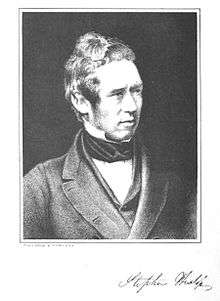Stephen Hislop
| Stephen Hislop | |
|---|---|
.jpg) Salted paper print (ca 1845) of Revd Stephen Hislop (1817–1863) | |
| Born |
8 September 1817 Duns, Berwickshire, Scotland |
| Died |
4 September 1863 Bori River, Takalghat, India |
| Resting place | Nagpur, India |
| Nationality | Scottish |
| Education | University of Glasgow, University of Edinburgh |
| Occupation | Missionary; Geologist |
| Employer | Free Church of Scotland |
| Spouse(s) | Erasma Hall |
| Parent(s) | Stephen Hislop, Margaret Thomson |
The Reverend Stephen Hislop (8 September 1817, Duns, Scotland – 4 September 1863, Takalghat), was a missionary to India, an educationist and a keen geologist. Hislop College, Nagpur is named after him, as is the green mineral Hislopite. Among his geological discoveries is the fossil reptile, Brachyops laticeps.
Early life
Hislop was educated at Thomas Sherriff's school in Duns, and then at the University of Glasgow and the University of Edinburgh.[1]:7–8 As a boy, he collected insects in the country around Duns, and rocks such as copper ore from old mine workings.[1]:12
Hislop married Erasma Hull.[1]:20
Career

In 1843, Hislop was made Secretary of the Ladies' Society for Female Education in India.[2]
Hislop was ordained as a Free Church of Scotland minister in 1844.[2] He was sent to India to work as a missionary, arriving via Bombay on 13 December 1844.[1]:31 He lived and worked in the Vidarbha area of Eastern Maharashtra near Nagpur for 18 years. He spent the first 15 months learning Marathi.[3] As soon as he was fluent he began his missionary work, opening a school in Nagpur in May 1846; it later developed into Hislop College.[4]
Reception
Sir Richard Temple praised Hislop as "among the most gifted and accomplished missionaries whom this generation has seen in India"; as being notable "for philology and antiquarian research"; and "for physical science, especially botany and geology".[5]
Geology and natural history
.jpg)
Hislop was assisted by another Free Church of Scotland missionary, Robert Hunter (1823-1897), who later edited the Encyclopædic Dictionary.[6] Both men were naturalists and keen amateur geologists, and as they walked the area around Nagpur, studied the local geology and sent papers home to be read at the Royal Geological Society in London.[1]:1
Joint papers with Hunter for the RGS included "On the Geology of the Neighbourhood of Nagpur, Central India"; "On the connection of the Umret Coal Beds with the Plant-beds of Nagpur, and of both with those of Burdwan".
Papers by Hislop (after Hunter became ill and returned to Britain) for the RGS included "Tertiary Deposits associated with Trap-Rock in the East Indies, and Fossil-shells from those deposits"; "On the Age of the fossiliferous thin-bedded Sandstone and Coal of Nagpur";[6] "Supplementary Note on the Plant-bearing Sandstone of Central India";[7] and "Fossil Teeth and Bones of Reptiles from Central India".[6]
The finds by Hislop and Hunter included a new species of Labyrinthodont reptile, Brachyops laticeps that was described by Richard Owen in 1854.[6][8]
Hislop wrote three papers for the Royal Asiatic Society's Journal: "Geology of the Nagpoor State"; "On the Age of the Coal Strata in Western Bengal and Central India"; and "Remarks on the Geology of Nagpoor".[4]
The mineral Hislopite was named after Hislop by his friend the Rev. Prof. Haughton in 1860.[6]
Activities
In 1857, Hislop's connections to local people were instrumental in saving the lives of the Europeans in Nagpur: one of his Muslim friends warned him of an impending attack during the "Indian mutiny";[4] among the rebellion's causes was the public auction of the jewels of Nagpur's royal family.[9]
Hislop wrote several essays on different, mostly Dravidian, tribes of the Nagpur region. These essays were published posthumously by R. Temple in 1866. This work resulted in a mission for the Gondi people.[2]
According the entry on Hislop in the Dictionary of National Biography, he also worked on the geology of the Nagpur region and published his findings in three papers for the British Association in 1859.[4]
Legacy
On 4 September 1863, Hislop drowned in the Bori River near Takalghat. Hislop College, Nagpur, founded twenty years later in 1883, and the oldest college in Nagpur, is named after him.[3]
Bibliography
- Smith, George. Stephen Hislop: Pioneer Missionary & Naturalist in Central India. John Murray, Albemarle Street. London, 1888. PDF
- Kingsford, Charles Lethbridge. Hislop, Stephen. Dictionary of National Biography, 1885–1900, Volume 27.
- Geological Society. "Obituary: Hislop, Rev Stephen". 1864. The Geological Society. Quarterly Journal 20.
- Free Church of Scotland (Continuing). Stephen Hislop, a Free Church Pioneer. The Explorer, November 2010. Pages 4–5.
References
| Wikisource has original text related to this article: |
- 1 2 3 4 5 George Smith, 1888.
- 1 2 3 "Hill & Adamson Collection". Rev Stephen Hislop. University of Glasgow. Retrieved 17 March 2012.
- 1 2 "Founder History". Hislop College. Archived from the original on 17 March 2012. Retrieved 17 March 2012.
- 1 2 3 4 Dictionary of National Biography, 1885–1900, Volume 27.
- ↑ Temple, Sir Richard. "Men and Events of my Time in India". John Murray, Albemarle Street, London, 1882. Page 241.
- 1 2 3 4 5 "H.W.": Obituary: The Rev. Robert Hunter, M.A., LL.D., F.G.S. Geological Magazine. Volume 4. Issue 08. pp 382–384. Published online: 1 May 2009. DOI:10.1017/S0016756800184249.
- ↑ Hislop, Stephen (Letter, Nagpur, 19 July 1861. Printed February 1862, page 36.). "Supplemental Note on the Plant-Bearing Sandstones of Central India". Proceedings of the Geological Society. Retrieved 18 March 2012. Check date values in:
|date=(help) - ↑ Owen, Richard (1854). "Description of the Cranium of a Labyrinthodont Reptile (Brachyops laticeps) from Mangali, Central India". Quarterly Journal of the Geological Society. pp. v. 10, issue.1–2, p. 473–474, . Retrieved 18 March 2012.
- ↑ Collier, Richard. The Great Indian Mutiny. New York: Dutton, 1964.